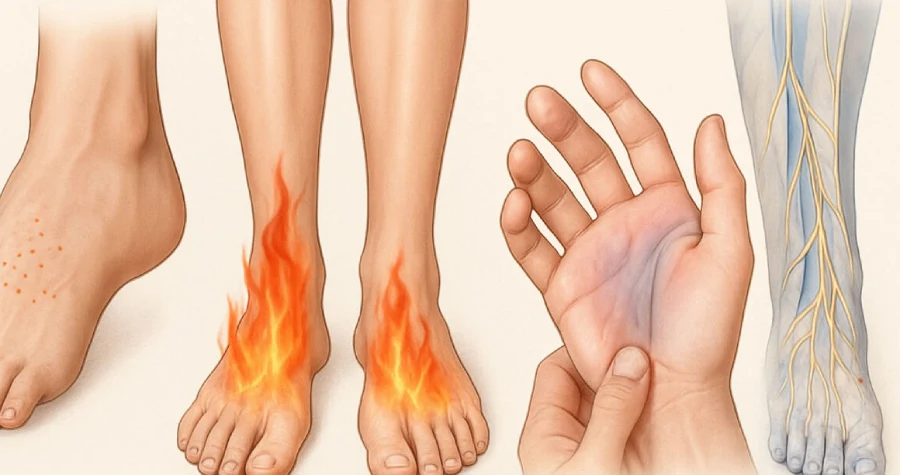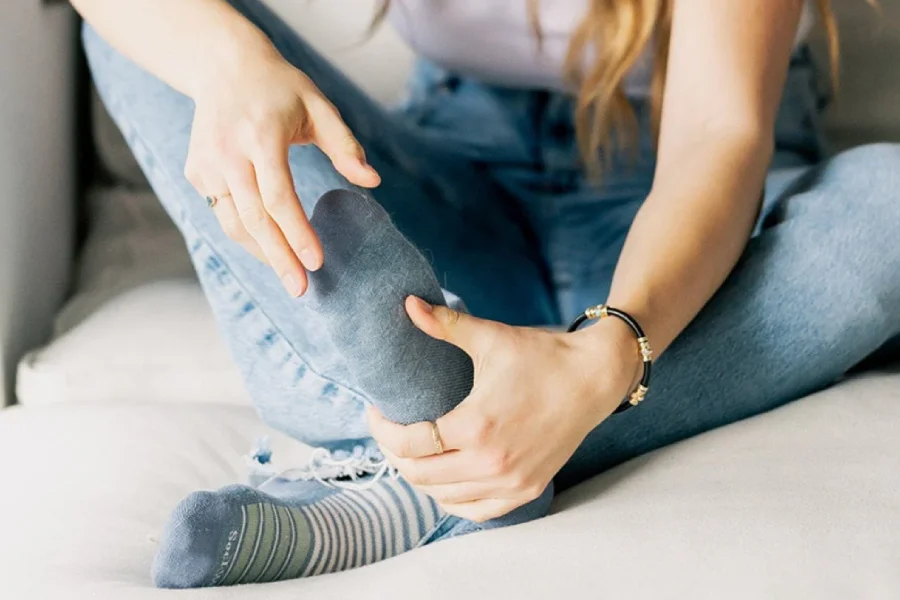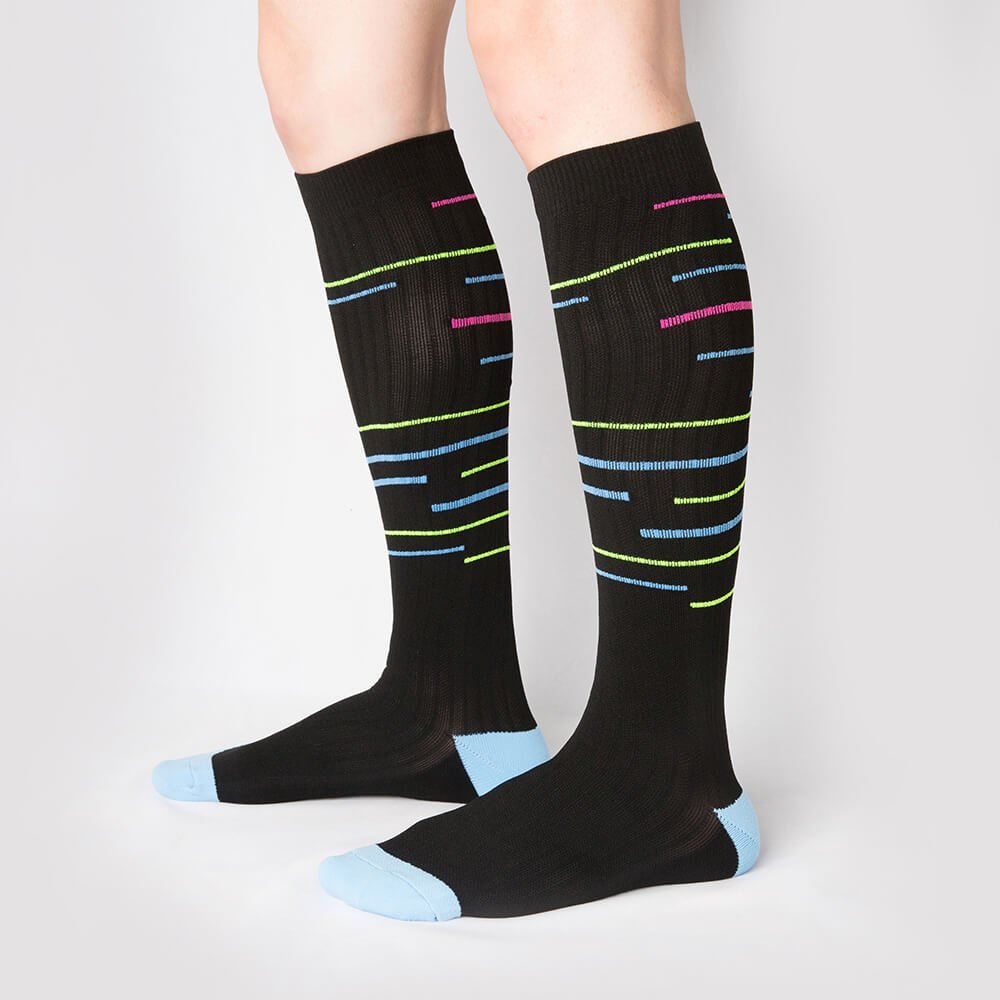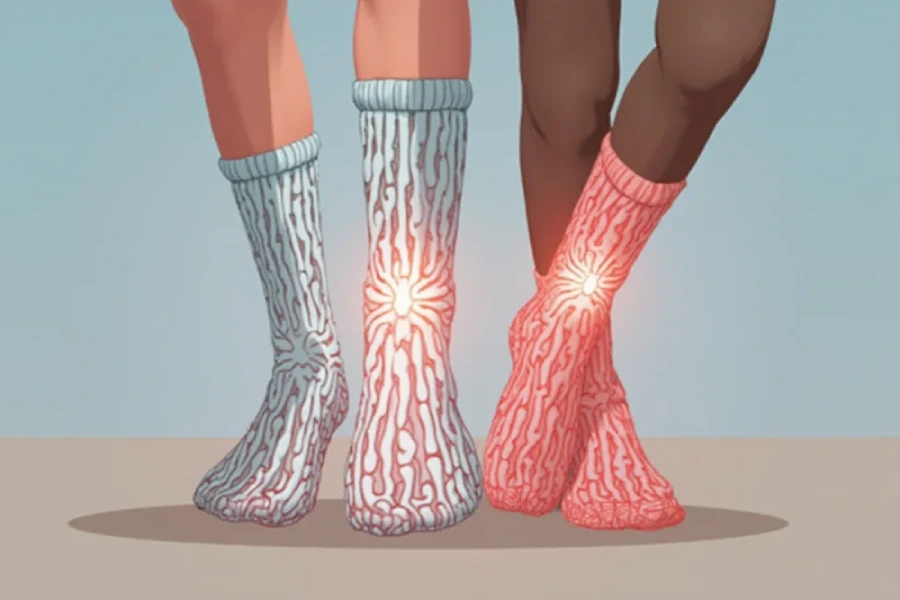Introduction: The Complex Relationship Between Compression and Neuropathy
Do compression socks actually help with neuropathy? For medical supply brands and product teams, this question is key. The market is large—and growing—but the guidance is often contradictory. Some claim compression offers real relief, others warn of potential harm. The truth is complex. The effectiveness of compression depends on the type, level, and design features. At Max Hosiery, we focus on safe, functional compression solutions. This guide breaks down the science, risks, and product criteria to help you confidently develop neuropathy socks that are both effective and safe for long-term wear.

What is Neuropathy and How Does it Affect the Feet?
To design a neuropathy sock that truly helps, you need to understand what you’re solving. Neuropathy—specifically peripheral neuropathy—is nerve damage that disrupts the communication between feet and brain. It’s especially common in people with diabetes, and it turns the simple act of wearing socks into a painful, risky experience.
Common symptoms include:
- Tingling or “Pins and Needles”: Known as paresthesia, this sensation ranges from mild discomfort to severe burning.
- Numbness: Loss of feeling means minor injuries or pressure points often go unnoticed, risking infections.
- Burning or Icy Pain: Many experience sharp, unpredictable pain or extreme cold sensations.
- Loss of Balance: Damaged nerves affect coordination, increasing the risk of falls.
- Extreme Sensitivity (Allodynia): Even a sock seam can cause intense pain, making comfort hard to achieve.
For your brand, this changes everything. You’re not selling socks—you’re offering relief. A true neuropathy sock must address all these issues. That means no irritating seams, no constricting cuffs, and materials that stay soft, breathable, and safe for fragile skin.
Understanding these symptoms isn’t just empathetic—it’s strategic. The more your product aligns with real user needs, the more trust, loyalty, and differentiation you build in the market.
The Science of Compression: How Do These Socks Actually Work?
To understand the potential benefits of compression socks for neuropathy, you need to first understand how these garments interact with the circulatory system. The core mechanism is called graduated compression, which applies controlled pressure to the leg in a downward gradient—tightest at the ankle and decreasing up the calf.
This structure supports venous return—the process of moving deoxygenated blood back to the heart. Veins, unlike arteries, rely heavily on muscle contractions and valves to move blood upward. For individuals standing or sitting for long periods, especially those with circulation issues, gravity can cause blood to pool in the lower extremities. This leads to swelling, fatigue, and worsened neuropathy symptoms.
Graduated compression works by:
- Applying maximum pressure at the ankle, where venous pressure is highest.
- Gradually reducing pressure up the leg, creating a flow gradient that encourages upward movement of blood.
- Increasing venous velocity, helping reduce blood stagnation and supporting healthier circulation.
Better circulation means more oxygen and nutrients to tissues, reduced swelling, and potentially less pressure on peripheral nerves—conditions that are critical for those managing neuropathy. It’s not just about tight socks; it’s about targeted physiological support.
For brands or medical suppliers developing neuropathy-friendly socks, offering gentle graduated compression (typically 8–15 mmHg) can create meaningful value for users without compromising comfort or safety. But success depends on proper material choice, construction, and compression control—factors that must be tightly managed during manufacturing.the nerves in the feet and legs, which is the foundation of their potential benefits for neuropathy sufferers.
The Key Benefits: How Can Compression Socks Alleviate Neuropathy Symptoms?
Compression socks aren’t a cure for neuropathy—but they’re one of the few non-invasive tools that can genuinely reduce daily discomfort. For brand owners and buyers, understanding their clinical utility helps shape both product development and messaging that truly resonates with end users.
Here are four targeted ways compression socks can improve the lives of neuropathy sufferers:
Reduces Swelling (Edema):
Neuropathy often comes with poor circulation and fluid buildup in the lower legs. Swelling increases pressure on already damaged nerves, intensifying pain. Graduated compression gently pushes excess fluid back into the circulatory system, relieving pressure and helping reduce this aggravating symptom.
Alleviates Aching and Pain:
By improving blood flow and oxygen delivery, compression socks reduce the muscle fatigue and aching often associated with neuropathy. Some users even describe a calming “hugging” sensation from the gentle pressure, which may help override sharp or erratic nerve signals.
Improves Stability and Body Awareness:
Neuropathy reduces foot sensation, increasing fall risk. The light, constant compression enhances proprioception—the body’s awareness of limb position—by stimulating skin receptors. This can help wearers feel more balanced and confident while walking.
Protects Sensitive Skin:
A quality neuropathy sock does more than compress. It shields numb or hypersensitive feet from bumps, scrapes, and irritation. Seamless, soft fabrics like bamboo or combed cotton reduce friction, making them ideal for allodynia-prone users.
For brands, this means your neuropathy sock needs to do more than just apply pressure. It should visibly support these four outcomes—swelling control, pain relief, balance improvement, and skin protection. This forms the foundation for a product that isn’t just functional, but deeply valuable to those living with neuropathy.
The Critical Caveat: When Are Compression Socks NOT Recommended for Neuropathy?
This is arguably the most important section of this entire guide. Building a trustworthy brand means being honest about not only the benefits but also the risks of your product. While compression socks can be a great help for many neuropathy sufferers, there are specific situations where they can be ineffective or even dangerous. Understanding and clearly communicating these contraindications is a non-negotiable part of responsible marketing and product development.
The primary concern is this: If a person’s neuropathy is accompanied by certain other vascular conditions, adding external compression can do more harm than good. The two biggest red flags are severe peripheral artery disease (PAD) and significant sensory loss.
Peripheral Artery Disease (PAD)
- The Problem: PAD is a condition where the arteries that supply blood to the legs and feet become narrowed due to plaque buildup. This means arterial blood flow is already compromised.
- The Risk: Standard compression socks are designed to help venous (outbound) blood flow. However, the external pressure they apply can further constrict already-narrowed arteries, dangerously reducing the supply of oxygen-rich blood to the feet. This can lead to increased pain, tissue damage, and worsen the underlying condition.
- The Rule: For individuals with a known or suspected diagnosis of PAD, standard over-the-counter compression socks are generally not recommended. Any use of compression must be done under the strict supervision of a doctor who can assess their arterial health.
Severe Sensory Loss
- The Problem: Some individuals with advanced neuropathy have such profound numbness that they cannot feel pressure, pain, or temperature in their feet.
- The Risk: If a sock is too tight, bunches up, or has a rough seam, a person with severe sensory loss may not feel the irritation or constriction it’s causing. They could wear the sock for hours while it is unknowingly cutting into their skin, restricting blood flow, or creating a pressure sore.
- The Rule: For these individuals, extreme care must be taken. If compression is used, it should be a very light level, and the sock must be impeccably constructed (e.g., seamless, non-binding). Daily foot inspections are essential.
The takeaway for your brand is this: Always include a clear disclaimer with your product advising customers to consult with their healthcare provider before using compression socks, especially if they have known circulatory issues or severe numbness. This protects your customer and builds trust by showing your brand prioritizes safety above all else.
Choosing the Right Compression Level (mmHg) for Neuropathic Relief
Not all compression is created equal. The level of pressure a sock provides, measured in millimeters of mercury (mmHg), is a critical factor in its safety and effectiveness, especially for individuals with neuropathy. Choosing the wrong level can be the difference between providing gentle, soothing relief and causing uncomfortable, or even harmful, constriction. As a brand, offering the right compression levels and educating your customers on their use is essential.

Here’s the deal. For neuropathy, the mantra is often “less is more.” Unlike an athlete seeking firm compression for muscle recovery, a neuropathy sufferer primarily needs gentle support to improve circulation without irritating sensitive skin or constricting blood flow to compromised nerves.
Understanding the Compression Tiers
- 8-15 mmHg (Mild Compression): This is often the ideal starting point for neuropathy. It provides a gentle, comforting hug that can help reduce mild swelling and improve circulation without feeling restrictive. It’s the safest choice for those with sensitive feet or for customers trying compression for the first time.
- 15-20 mmHg (Moderate Compression): This level can also be beneficial, particularly for individuals who experience more significant swelling or aching in their legs and feet. It provides noticeable support and is a common choice for diabetic socks that incorporate compression. However, it’s crucial that socks at this level have a non-binding top and a comfortable fit.
- 20-30 mmHg (Firm Compression) and Higher: These higher levels are generally not recommended for the average neuropathy sufferer unless they are specifically prescribed and monitored by a doctor. The risk of the compression being too intense and causing issues for those with underlying vascular problems or sensory loss is much greater at these levels.
Your product strategy should reflect this. When developing a private label sock for neuropathy, focus on the mild and moderate ranges. Your marketing message should emphasize “gentle support” and “soothing comfort” rather than “firm pressure.”
Here’s a table to help you position your offerings:
| Compression Level | Sensation & Feel | Suitability for Neuropathy | Key Selling Point |
|---|---|---|---|
| 8-15 mmHg | Gentle, soothing hug | Highly Recommended. Ideal starting point. | “All-day comfort and gentle circulatory support.” |
| 15-20 mmHg | Noticeable, supportive squeeze | Suitable for many. Good for managing swelling. | “Effective relief from swelling and leg fatigue.” |
| 20-30 mmHg+ | Firm to very tight | Not generally recommended. Use only under medical advice. | Marketed for athletic recovery or other specific uses, not general neuropathy. |
Why Material and Fit are Non-Negotiable for Neuropathy Socks
For a person with neuropathy, a sock is not just an accessory; it’s an intimate layer that is in direct contact with highly sensitive, vulnerable skin for hours at a time. This is why the material composition and the construction of the sock are just as important—if not more so—than the compression level. A sock made from scratchy material or with a thick, irritating seam can cause more pain than it relieves. As a brand, focusing on these comfort-driven features is what will set your neuropathy sock apart as a truly premium, therapeutic product.
Let’s dive into the details that matter most.
The Crucial Role of Soft, Breathable Materials
The yarn you choose is the foundation of comfort. The goal is to create a healthy, dry, and low-friction environment for the foot.
- Bamboo Fiber: Often considered a top-tier choice for diabetic and neuropathy socks. It is exceptionally soft, naturally moisture-wicking (pulling sweat away from the skin), breathable, and has antimicrobial properties, which can help reduce the risk of infection.
- Combed or Merino Cotton: High-quality cotton is soft and breathable. Combed cotton, which has had its shorter fibers removed, results in a softer, stronger yarn. Merino wool is another excellent option for its softness and superior temperature-regulating properties.
- Copper or Silver-Infused Yarns: Some advanced materials infuse fibers with copper or silver ions. These elements have natural antimicrobial and anti-fungal properties, which can further help to maintain a healthy foot environment and reduce odor.
- Avoid: Rough, synthetic materials like standard polyester can trap heat and moisture, which can lead to skin irritation and a higher risk of fungal infections.
The Importance of Seamless and Non-Binding Construction
The way the sock is built can make a world of difference.
- Seamless Toe: This is a non-negotiable feature. A traditional sock has a thick, rope-like seam across the toes. For a person with neuropathy, this seam can rub and cause blisters or sores they may not even feel. A true seamless toe, created by hand-linking the closure, results in a completely flat and smooth seam that eliminates this risk.
- Non-Binding Top: The welt, or top band of the sock, should be designed to stay up without digging into the leg. A tight, restrictive top band can interfere with circulation—the very thing you’re trying to improve. Look for a “diabetic top” or a non-binding design that provides gentle hold without constriction.
- Anatomical Fit: A well-designed sock will have a shaped heel and a comfortable fit that conforms to the foot without bunching or wrinkling, which can also cause pressure points.
Graduated vs. Uniform Compression: What’s the Best Approach?

When you’re developing or sourcing a compression sock for neuropathy, it’s essential to understand that not all “tight socks” are the same. You will encounter products that offer uniform compression and those that offer graduated compression. For providing true therapeutic benefit and ensuring safety, the difference is night and day. As a brand, aligning your products with the medically-proven technology of graduated compression is key to building credibility and effectiveness.
Let’s clarify the distinction.
Uniform Compression
This is simply a sock that is tight all over. It provides the same amount of pressure at the ankle, the calf, and the top band. While this might feel supportive initially, it is not an effective way to promote circulation.
- The Problem: If the pressure is the same throughout the leg, it doesn’t create the necessary gradient to help push blood “uphill” against gravity. In some cases, if the top band is too tight, it can even act like a tourniquet, hindering circulation rather than helping it. Think of it like squeezing a tube of toothpaste equally from both ends—not much comes out.
Graduated Compression
This is the technology we discussed earlier and the one endorsed by the medical community for promoting circulation. It is an engineered system of pressure designed to work with your body.
- The Solution: By applying the maximum pressure at the ankle and gradually decreasing that pressure up the leg, it creates a “pump” effect. This gentle, upward squeeze efficiently moves stagnant blood and fluid out of the lower leg, reducing swelling and improving overall circulation. It’s like squeezing a tube of toothpaste correctly from the bottom up.
Why is this critical for neuropathy? People with neuropathy often already have compromised circulation as a contributing factor to their condition. Therefore, using a tool that is specifically designed to enhance circulation is paramount.
- Efficacy: Graduated compression is more effective at reducing the swelling that can put painful pressure on damaged nerves.
- Safety: A properly designed graduated compression sock is less likely to have a dangerously tight top band that could restrict blood flow, a major concern for this user group.
The takeaway for your brand is simple: When you market your socks, use the term “graduated compression” and explain what it means. This signals to the consumer that your product is a serious, therapeutic device, not just a pair of tight socks. It’s a key differentiator that speaks to quality and scientific design.
The Doctor’s Role: Why Medical Consultation is Essential
If your brand sells compression socks for neuropathy, promoting safe use isn’t just a suggestion—it’s a responsibility. The most important message you can share with customers is: consult a healthcare professional before use.
Here’s why that matters:
Ruling Out Hidden Risks
Some conditions, like Peripheral Artery Disease (PAD), make compression dangerous. Many people don’t realize they have PAD. A doctor can run simple tests—like an ankle-brachial index (ABI)—to confirm whether compression is appropriate.
Confirming the Right Diagnosis
Tingling or numb feet might suggest neuropathy, but other conditions can cause similar symptoms. Only a medical professional can confirm the diagnosis and avoid inappropriate treatment paths.
Choosing the Right Compression Level
While 8–15 mmHg is generally safe, individual needs vary. A doctor can assess swelling, circulation, and overall health to recommend the correct pressure level—reducing the risk of adverse effects.
Supporting a Holistic Care Plan
Compression socks are one part of a broader treatment strategy that may include medication, therapy, or lifestyle changes. A doctor helps patients integrate the product safely and effectively.
How to Position This Responsibly:
Clearly communicate on packaging and product pages with statements like:
- “Consult your physician before use—especially if you have heart or circulation issues.”
- “This product supports symptom relief but is not a substitute for medical treatment.”
By encouraging doctor involvement, you protect your customers and elevate your brand’s credibility. You’re not just selling a sock—you’re part of a care strategy. That distinction builds lasting trust.le.
Marketing Your Neuropathy Socks: A Guide for Brand Owners
You’ve developed a therapeutic sock designed for real relief—now it’s time to market it the right way. With medical-related products, your messaging must focus on trust, safety, and clarity—not hype.
Lead with Comfort and Safety
Neuropathy sufferers want one thing: comfort. Focus your messaging on features that address this directly:
- Seamless Toe: “Irritation-free design to protect sensitive skin.”
- Bamboo Fabric: “Soft, breathable, moisture-wicking fibers for lasting comfort.”
- Non-Binding Top: “Stays in place without restricting circulation.”
Avoid Medical Claims
Don’t promise a cure. Instead, highlight benefits people can feel:
- Swap “Cures foot pain” with “Helps reduce swelling and daily foot discomfort.”
- Instead of “Prevents falls,” say “Designed for gentle support and added stability.”
These small shifts build credibility and help you stay compliant with ad guidelines.
Position Your Brand as an Educator
Your customers may not fully understand neuropathy or how compression helps. Use blog articles, videos, and foot care guides to explain:
- What neuropathy is
- Why gentle compression matters
- How to choose the right sock size
This builds trust and differentiates you from generic retailers.
Beyond the Sock: Complementary Therapies for Neuropathy
While a well-designed compression sock can be an incredibly valuable tool, it’s important to position it as one component of a larger wellness strategy. For a brand, providing this holistic context adds immense value for your customers. It shows that you are not just selling a product, but are genuinely invested in their overall well-being. Educating customers about complementary therapies can help them achieve better results and will further solidify your brand’s reputation as a trusted expert in foot and leg health.
What else can help? Encourage your customers to discuss these complementary approaches with their healthcare provider.
Proper Footwear
- The Connection: The best socks in the world can’t overcome the problems caused by ill-fitting shoes. Shoes that are too tight can worsen circulatory issues, while shoes with inadequate support can lead to foot fatigue and pain.
- The Advice: Recommend shoes with a wide toe box to prevent pinching, good arch support, and cushioned soles to absorb impact. Many brands specialize in therapeutic footwear designed for diabetic or neuropathic feet.
Gentle Exercise
- The Connection: Regular, gentle movement is one of the best ways to improve blood flow to the legs and feet. Exercise can also help improve balance, strength, and can sometimes reduce neuropathic pain.
- The Advice: Activities like walking, swimming, or using a stationary bike are excellent low-impact options. Simple seated exercises, like ankle rotations and calf stretches, can also be very beneficial.
Daily Foot Inspections
- The Connection: Due to potential numbness, a person with neuropathy might not notice a small cut, blister, or ingrown toenail. If left untreated, these minor issues can become serious infections.
- The Advice: Emphasize the importance of visually inspecting the feet every single day. They should look for any redness, sores, or changes in the skin, especially between the toes and on the soles of the feet.
A Healthy Diet and Blood Sugar Management
- The Connection: For individuals with diabetic neuropathy, managing blood sugar levels is the single most important factor in preventing the nerve damage from getting worse. A healthy diet rich in vitamins and antioxidants can also support nerve health.
- The Advice: While you are not giving medical advice, you can generally encourage a healthy lifestyle and direct them to resources like the American Diabetes Association for nutritional guidance.
By incorporating this information into your blog, social media, or product inserts, you empower your customers to take a more active role in their health.
Conclusion: Making an Informed Decision for Your Brand
So—do compression socks help neuropathy? Yes, when designed with care and worn correctly. For brands, this is a chance to create a product that offers real relief and builds trust with a growing, underserved market. But success hinges on more than tightness. It requires soft, breathable yarns, a seamless toe, gentle 8–15 mmHg compression, and a medical-grade approach to quality.

At Max Hosiery, we specialize in manufacturing socks that meet these exact standards. You bring the vision—we’ll handle the technical side. Contact us today for a free consultation and begin developing a product your customers can count on.
FAQ Section
Q1: What is the best material for a neuropathy compression sock?
For neuropathy, the best materials are exceptionally soft, breathable, and moisture-wicking to protect sensitive skin. Bamboo fiber is an excellent premium choice due to its softness and natural antimicrobial properties. High-quality combed cotton and specialty yarns infused with copper or silver are also great options.
Q2: Can I market my private label socks as “medical devices”?
Not unless you meet regulatory requirements like FDA registration. Most brands market these as “therapeutic,” “wellness,” or “diabetic-friendly” instead, focusing on comfort and function.
Q3: What is the most important design feature for a neuropathy sock?
A seamless toe is critical. Traditional seams can cause pressure and irritation, especially for those with nerve sensitivity. Flat seams prevent friction and improve safety.
Q4: Should neuropathy socks be worn to bed?
Generally, no. Compression socks are designed to work against gravity while you are awake and upright. It is usually not necessary to wear them while lying flat and could potentially cause constriction if the sock bunches up. This should only be done if specifically instructed by a doctor.
Q5: What compression level should I offer for a general neuropathy sock line?
Start with 8–15 mmHg. It’s gentle, safe, and ideal for most neuropathy users. Only offer 15–20 mmHg with proper guidance and clear labeling.
